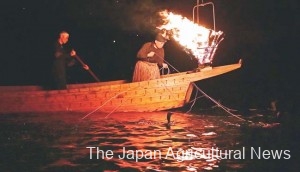GIFU, Oct. 2 ― The Nagara River, considered one of Japan’s three clearest rivers and known for the ayu sweetfish fishing, supports a population of 860,000 people living in the basin from upstream through downstream.
Ayu of the Nagara River was designated as a Globally Important Agricultural Heritage System by the United Nations Food and Agriculture Organization in 2015 as satokawa, a river that enriches the lives of people in various forms including culture, industry and traditional craftwork.
Seiryu Nagara River Ayu Park in the city of Gujo located in the upstream of the river allows visitors to experience live decoy fishing called tomozuri and ayu hand grabbing, as well as enjoying eating the fish they caught grilled with salt.
It received a total of 800,000 visitors in five years, offering hands-on learning experience to elementary and junior high school students and others.
According to Yosuke Mugishima, 45, who manages the park, a questionnaire answered by visitors showed that 60 percent of the respondents said it was their first time to experience river fishing.
As people today become less familiar with rivers and with the change in environment, including a decline in the number of fishers and sweetfish, there is increasing need to encourage people to visit the Nagara River for education purposes and to nurture personnel who conserve and promote the area.
It is said that sweetfish which feed on river algae growing in the clear waters have a cucumber-like aroma, the reason why the fish is called “the queen of the clear waters.”
Live decoy fishing involves placing a hook on a decoy ayu and letting it swim in the other fish’s territory to hook a new ayu by using the natural tendencies of the fish to attack other bodies that invade their territory.
It is a fishing method devised by people well-versed in the habits of ayu, indicating the long history of humans coexisting with the river.
This is the essence of the Nagara River system in which people receive the blessings of nature by utilizing the ecosystem.
The ukai cormorant fishing, a traditional fishing method which uses trained cormorants to catch ayu, boasts a history of some 1,300 years and has been designated as a national important intangible folk cultural property.
The tradition has been inherited by nine cormorant fishing masters known as usho who are appointed to the position of shikibushoku, officials responsible for the Imperial Household Agency’s ceremonies.
The ukai performance was also highly praised by renowned English comic silent film icon Charlie Chaplin who saw it twice.
At 7 p.m., ubune wooden fishing boats each carrying a fire set off down the river in the darkness of the night.
Usho, clad in kazaori-eboshi courtier hat and koshi-mino apron costume made of straw, handle cormorants with tanawa leashes, and the cormorants catch ayu attracted by firelight.
The sparks flying over the river and the sound of water created by the cormorants offer a scene which remains unchanged for centuries.
Masahiko Sugiyama, 63, head of the Nagara River ukai fishing preservation society, takes care of 23 cormorants kept in a shed in the garden of his home.
Cormorants are fishing masters’ important partner. Sugiyama identifies each cormorant and recognizes each of their characteristics, and selects 10 to 12 of them everyday to take to ukai based on their health conditions.
New initiatives have been taken to foster personnel.
Ukai is supported by various people, including usho and people who steer the boats, and it is urgently needed to nurture artisans, boat builders in particular.
Shosuke Imai, 36, and Shohei Kunieda, 27, who work as boatmen under Sugiyama, are learning boatbuilding as part of a preservation program.
As the value of ukai shifts from fishing to tourism, the local people are building a coexistent relationship with the river which fosters culture and industry. Such efforts can serve as a model for Japan, blessed with mountains and rivers, to make use of regional resources.


